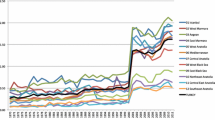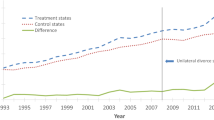Abstract
This paper estimates and discusses divorce measures in China and its 30 provinces since 1980. The propensity for divorce in China increased 42% between 1982 and 1990. Substantial increases in divorce were observed in all provinces except Xinjiang and Shanxi. We found a fairly strong regional pattern of divorce in China: Divorce rates were lowest on the east coast and in eastern areas, highest in the northwest and the northeast, and moderate in the middle and southern parts of the country. Descriptive explanations of trends and regional variations are presented.
Similar content being viewed by others
References
Chu, Z. 1994.“New Trend of Divorce Today” (in Chinese). Society 2:29–30.
Fu, X. 1992.“A Cross-National Analysis of the World Divorce Rate.” Encyclia 69:125–44.
Fukurai, H. and J. Alston. 1990.“Divorce in Contemporary Japan.” Journal of Biosocial Sciences 22:453–64.
Goode, W.J. 1993. World Changes in Divorce Patterns. New Haven: Yale University Press.
Honig, E. and G. Hershatter. 1988. Personal Voices: Chinese Women in the 1980s. Stanford: Stanford University Press.
Hutter, M. 1988. The Changing Family: Comparative Perspectives. New York: Macmillan.
Jones, G.W. 1997.“Modernization and Divorce: Contrasting Trends in Islamic Southeast Asia and the West.” Population and Development Review 23:95–114.
The Koran, translated into Chinese by Ma Jian. 1985. Beijing: Chinese Social Science Press.
Liao, C. and T.B. Heaton. 1992.“Divorce Trends and Differentials in China.” Journal of Comparative Family Studies 23:413–29.
Parish, W.L. and M.K. Whyte. 1978. Village and Family in Contemporary China. Chicago: University of Chicago Press.
Platte, E. 1988.“Divorce Trends and Patterns in China: Past and Present.” Pacific Affairs June:428-45.
SSB (State Statistical Bureau of China). 1986. China In-Depth Fertility Survey (Phase I), Principal Report. Vol. 1. Beijing: Department of Population Statistics, State Statistical Bureau.
—. 1989. China In-Depth Fertility Survey (Phase II), Principal Report. Vol. 1. Beijing: Department of Population Statistics, State Statistical Bureau.
—. 1993. Tabulations on the 1990 Population Census of People’s Republic of China (in Chinese). Beijing: China Statistical Press.
Statistical Yearbook of Taiwan. 1997. Taipei: Directorate General of Budget, Accounting and Statistics, Executive Yuan.
Sylvester, M.P. 1980.“The Islamic Talaq: Problems and Perspectives for the Future.” Journal of Social Welfare Law (September): 282-92.
Thornton, A., H.-S. Lin, and M.-L. Lee. 1992.“International Perspective on Changing Marital Formation and Dissolution in Taiwan.” Presented at the International Conference on Family Formation and Dissolution: Perspectives From East and West, Taipei, May 21–23.
United Nations. 1996. United Nations Demographic Yearbook, 1996. New York: United Nations.
Whyte, M.K. and W.L. Parish. 1984. Urban Life in Contemporary China. Chicago: University of Chicago Press.
Writers Group for Concise History of the Uygur Ethnic Group. 1988. Concise History of the Uygur Ethnic Group (in Chinese). Urumqi: Xinjiang People’s Press.
Wu Deqing. 1995.“Research on Divorce in Contemporary China” (in Chinese). PhD dissertation, Peking University.
Yang, D. 1987.“Defend the Right to Divorce, Guard Against Hasty Separations.” In New Trends in Chinese Marriage and the Family, published by Women of China and distributed by China International Book Trading Corporation, Beijing.
Zeng, Y., ed. 1995. Research on Divorce in the 1980s in China (in Chinese). Beijing: Peking University Press.
Zeng, Y., T.P. Schultz, and D. Wang. 1992.“An Event History Analysis of Divorce in China.” Discussion Paper 675, Economic Growth Center, Yale University.
Zhang, T. and R. Huang, eds. 1996. Population Surveys and Research for Ethnic Minority Groups in China (in Chinese). Beijing: Higher Education Press.
Author information
Authors and Affiliations
Corresponding author
Additional information
Suggestions and comments on the early draft provided by the anonymous reviewers, the editors, Wang Deyi, Li Rongshi, Cai Wenmei, Reng Qiang, Ma Rong, M.E. Hughes, Minja Kim Choe, Cai Qian, Gu Danan, Karl Brehmer, Tanya D. Exum-Coston, T. Paul Schultz, and Li Jianxin are highly appreciated.
Rights and permissions
About this article
Cite this article
Yi, Z., Deqing, W. A regional analysis of divorce in China since 1980. Demography 37, 215–219 (2000). https://doi.org/10.2307/2648123
Issue Date:
DOI: https://doi.org/10.2307/2648123




